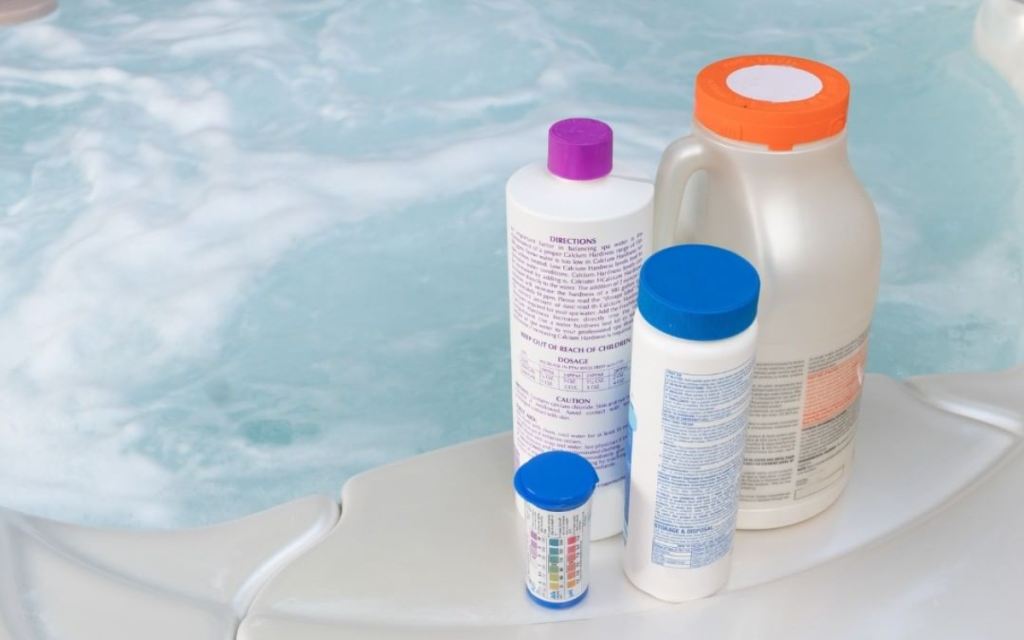Adjusting the water chemistry can be a really frustrating experience. Some metrics are very stubborn, while others don’t seem to show up on a testing strip at all. Even more so, the order in which to add chemicals and the proper dosage are unclear. We decided to group the best chemicals for inflatable hot tub maintenance by the stages of the regular care process and explain how to use them properly.
We know that quite a few choices a hot tub owner faces are situational, so we offer alternatives in our best chemicals for inflatable hot tub care list and explain under which circumstances you should opt for them. You also need to know about several chemicals that are as important, just less frequently used. And finally, there are many common mistakes we often see in our practice, like not turning on the hot tub jets when adding chemicals. So, if you want to upgrade your inflatable hot tub chemical kit to keep your water clean with minimal effort—keep reading!
Best Chemicals for Inflatable Hot Tub to Always Be on Hand
In this table, we’ve gathered the most necessary and reliable products you always need to have in your inflatable hot tub chemical kit. In some situations, however, you might want to go for alternative options, which you can find in the detailed overview of the maintenance process.
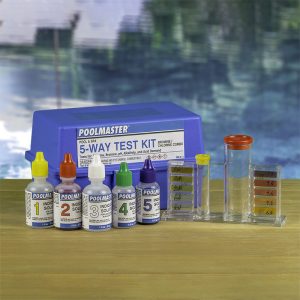 Poolmaster: 5-Way Spa Water Test Kit Winning category: Most reliable testing materials | Jump to the detailed review |
|
 Leisure Time: Balancer for Spas and Hot Tubs Winning category: Best for decreasing pH and alkalinity | Jump to the detailed review |
|
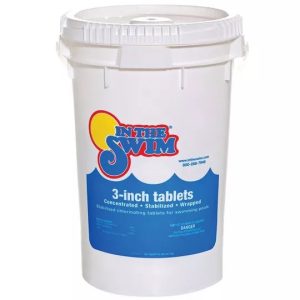 In the Swim: Chlorine Tablets Winning category: Best for hot tub sanitizing | Jump to the detailed review |
|
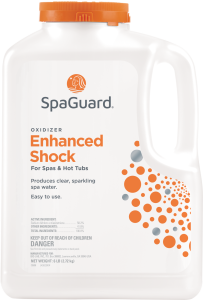 SpaGuard: Enhanced Shock Winning category: Best at eliminating contaminants | Jump to the detailed review |
|
Is the Cure Worse than the Disease with Inflatable Hot Tub Care?
The first and most important question we get asked when it comes to spa maintenance is: “Do you even need chemicals for an inflatable hot tub?” The answer is a definitive yes, and you should not neglect any stage of the process we describe. Let’s find out why inflatable hot tub care is essential and which goals we achieve by adding chemicals to the water.
🦠 Keeping bacteria under control
One of the primary functions of hot tub chemicals is to eliminate harmful bacteria and microorganisms that often live in warm water. Without proper sanitation, your hot tub can become a breeding ground for pathogens, creating a significant health threat to you and your family. The list of dangers includes skin diseases, digestive system issues, lung infections, and other nasty things you don’t want to deal with. Sanitizers like chlorine or bromine are responsible for keeping these harmful elements out of the water.
👌 Making water properties safe for swimming
The level of pH is the most essential metric when it comes to safe swimming. If your acidity levels are out of balance, your bathing experience will be far from pleasant. A high pH level means the water is too alkaline, and you risk a very unpleasant skin rash. On the other hand, if the pH is too low, your eyes and nose might burn due to the overly acidic water. Adjusting the pH level is probably the trickiest part of inflatable hot tub maintenance, so we must pay specific attention to it.

⚙️ Protecting the equipment
Hot tubs use many machinery components, like heaters, pumps, or filters. Even if the water is fine for humans, it’s not necessarily okay for the equipment. Chemical maintenance is a must to protect these components from corrosion and scaling. Properly balanced water reduces the buildup of scale, which otherwise would reduce the longevity of the equipment, and prevents corrosion that can lead to costly repairs. In this regard, calcium hardness is a metric you need to monitor.
Now that you know the goals, let’s figure out what chemicals you need for an inflatable hot tub.
Inflatable Spa Chemicals: Every Maintenance Step Explained
Here, we will discuss 4 essential steps of weekly hot tub care and the best chemicals for an inflatable hot tub to ensure suitable water chemistry. For each maintenance stage, we’ve selected the best product overall and a viable alternative option that might work better under specific conditions. Some brands are good with one type of product, but not so much with the other ones, so buying these products separately can save you money and increase the overall effectiveness. But if you want to have all the chemicals come in a bundle, you should check out our article about the best hot tub chemical kits.
Testing Waters: Are Usual Test Strips Enough?
 Poolmaster: 5-Way Spa Water Test Kit | 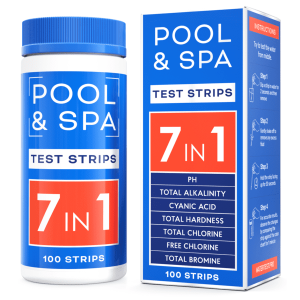 Bestprod: 7-in-1 Pool and Spa Test Strips |
Most reliable testing materials | Cheaper and faster results |
| + More reliable and consistent + Safer packaging + Results are easy to read - More expensive - Time-consuming measurement process - Analyzes fewer metrics | + Slightly cheaper + The process takes less than a minute + Accounts for more metrics - Less precise, especially for cyanuric acid - Becomes unusable if not stored carefully - Colors on the scale can be hard to distinguis |
Unsurprisingly, you can’t conduct any chemical adjustments without the baseline readings you get from the testing equipment. But what is the best way to get those? Usually, you have three options: using a testing kit, testing strips, or bringing your water samples to a local pool store. In most cases, regular cheap testing strips should be okay. However, the testing strip measurements will never be as precise as with the testing kit.
Additionally, testing strips often have problems with specific metrics—the most common issue, by far, is the . If it turns out that you struggle reading off the measurements, you’ll have to use many more strips each time, thus making the cost difference less significant. Our solution is to try to match the results from the testing kit, strips, and a pool store. If the testing strips’ measurements prove to be reliable, you can continue using those.
It is recommended to check the water quality with test strips or a chemical kit weekly and after rains or heavy use. Personally, I feel okay spending several extra minutes to get more precise data, but the choice is up to you.
Chemicals to Adjust Alkalinity and pH
 Leisure Time: Balancer for Spas and Hot Tubs |  Borax: 20 Mule Team Laundry Booster, Powder |
Best for decreasing pH and alkalinity | Best for increasing pH |
| + Lowers pH and alkalinity simultaneously + Quick action + Compatible with chlorine, bromine, and biguanide - The safety lid can be a bit too hard to take off | + Increases pH with no spikes in alkalinity + Widely available + Very cost-effective - If you need to raise both pH and alkalinity, it is better to use common baking soda |
This is the first adjustment you have to make and also the most confusing part of every hot tub maintenance tutorial, so let’s explore this topic. Alkalinity and pH are two different parameters. Alkalinity shows how capable the water is of neutralizing acids. pH represents the level of acidity. These metrics are interconnected, so the change in pH always causes a change in alkalinity (its significance depends on the chemical).
It is better to start by fixing the alkalinity before pH. The ideal value for the alkalinity level is between 100-150 ppm and 7.2-7.8 for the pH level. You need to add pH and alkalinity adjusting chemicals only if the water test shows the need for it. And here’s how you manage it:
- If the alkalinity is too low, use regular baking soda to increase it (and slightly increase pH)
- If the pH is too low, you can use the good old Borox powder to raise it (and slightly raise the alkalinity)
- If pH or alkalinity is too high, the only thing you can do is to use a pH decreaser. We recommend the pH and alkalinity decreaser by Leisure Time.
Choosing a Sanitizer: Chlorine, Bromine, or Else
 In the Swim: Chlorine Tablets | 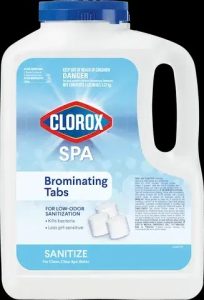 Clorox: Spa Bromine Tablets |
Best for hot tub sanitizing | Gentler health option |
| + The strongest bacteria and algae killer + The most cost-effective solution + Faster action - Has a rather strong and unpleasant smell - You need to use it more frequently than bromine | + Less harsh on the skin + Has no strong odor + The effects last longer - Less effective at killing bacteria - Significantly more expensive - Does not work too well under the sunlight |
The third step is using water sanitizer. The choice between chlorine and bromine is a neverending debate among hot tub owners. Both options have valuable advantages, and if you want to explore this tradeoff, we have a detailed article about that. However, we definitely recommend chlorine tablets for inflatable hot tubs if placed outdoors (which is very often the case). Bromine burns off under direct sunlight, which makes it much less effective compared to chlorine. The appropriate level of chlorine in the water is 1-3 ppm. Both chlorine and bromine should be added to a hot tub one or two times per week, depending on how frequently you use it.
The alternative options for hot tub sanitizing include biguanide and mineral systems, although they are less popular. If you want to use one of those, you need to make sure that they are compatible with your hot tub brand.
How to Shock an Inflatable Hot Tub the Right Way?
 SpaGuard: Enhanced Shock | 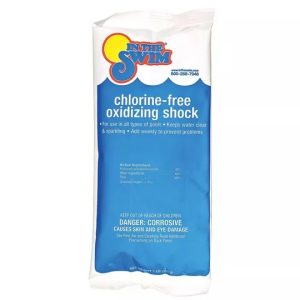 In the Swim: Chlorine-Free Shock |
Best at eliminating contaminants | Better option for mineral hot tub |
| + The best at dealing with all types of contaminants + Good in most hot tubs, except for the mineral spa + Serves as a clarifier and flocculant - Has to be pre-dissolved - Need to wait longer before using the hot tub | + The best to shock a mineral hot tub + Effects kick in much faster + Good for keeping chlorine levels low - Less effective at killing bacteria - Does not affect algae growth - Will require more frequent use |
The final decision you need to make is about how to shock an inflatable hot tub. Chlorine-free shock has several advantages: it allows you to get into the hot tub much sooner and works well in the mineral hot tub. But apart from that, it is just not as effective, so powerful Enhanced Shock by SpaGuard is our pick. You should use the inflatable hot tub shock weekly to keep your sanitizer effective and water clean.
These were the most crucial products for weekly maintenance, but there are other important ones you won’t need to use so often.
Other Chemicals that You’ll Need Less Frequently
Metal Sequestrant
It is especially important if you are doing your hot tub maintenance for the first time. Metal sequestration helps you bind iron and copper ions and prevent them from staining and scaling your hot tub.
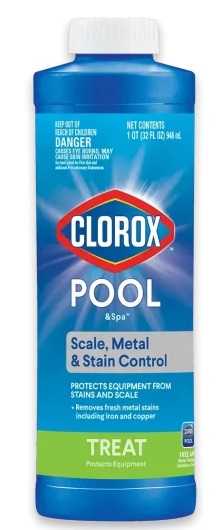
Best to remove excessive metals and prevent staining
Line Flush Cleaner
No matter how careful you are with the inflatable hot tub care, over months of usage, the pipes inside your hot tub will accumulate lots of pollutants and form a buildup. You can get rid of it by using a chemical called a line flush cleaner. Usually, you need to use it every 3–4 months, depending on how heavily the hot tub is used.

Best to maintain the pipeline system
Calcium Hardness Increaser
The calcium hardness increaser is a huge help if the hot tub water is too soft. Your ideal level of calcium hardness is 175-250 ppm. If this value dips below 175 ppm, the water might start damaging your pipeline system and hot tub shell. But you need to be careful not to overshoot it because if the water is too hard (above 250 ppm), the only thing left will be to drain the water completely.
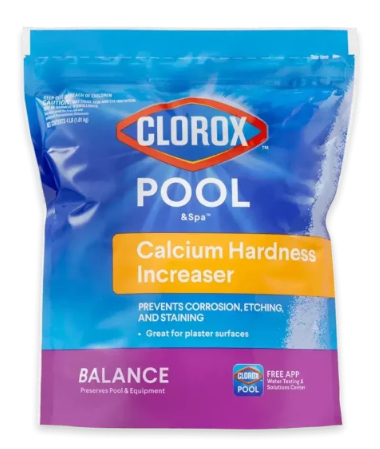
Best to manage the calcium level and prevent corrosion
Hot Tub Enzyme
Usually, hot tub enzyme is not used too frequently, however, it is better to have a bottle on hand. Enzymes are helpful when dealing with organic buildup, like body oils, lotions, or even leaves.

Best to get rid of organic buildup
The Most Common Pitfalls and 5 Tips to Avoid Those
- Mixing chemicals or adding them too soon
The first one is pretty simple, but it still is a mistake many hot tub owners make. Mixing chemicals straight up is never a good idea, but hastily adding them to the water can also diminish the overall effectiveness. It is recommended to always wait at least 20 minutes after adding one chemical before adding the next one.
- Not turning on the jets
Not all inflatable hot tubs have water jets, but models from this selection do. And turning them on can really help to disperse chemicals faster and increase their effectiveness.
- Not wearing protective gear
When working with chemicals for an inflatable hot tub, you deal with potentially dangerous substances. Chlorine is probably the most problematic, so we strongly recommend using protective goggles, gloves, and a mask to avoid damaging mucous membranes when putting the chlorine tablets in the hot tub.
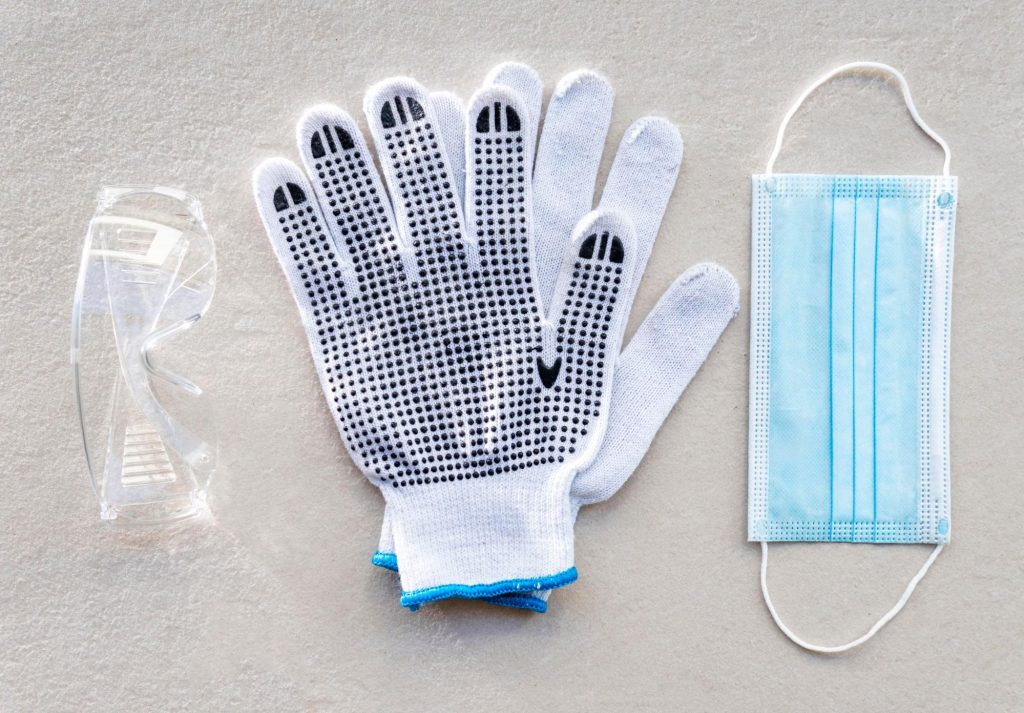
- Turning on the air valves
When the air valves are turned on, they cause the chemicals you’ve added to off-gas way too quickly, thus reducing their concentration and effectiveness.
- Not using the hot tub heater
Using the hot tub heater can substantially slow down the inflatable hot tub maintenance process. When the water is warm, the chemicals dissolve faster, and their effect starts to kick in much quicker.
Summary
Inflatable hot tub maintenance can be challenging, and it takes time to master the process. Our goal was to find the most reliable solutions to the most confusing aspects of the maintenance routine. With this article, it will be easy for you to find the best chemicals for inflatable hot tub care, as well as navigate through the process of using them with the highest effectiveness.
We covered the reasons why hot tub chemistry is important, selected must-have products, and useful additions that can expand your chemical kit for an inflatable hot tub. You can also benefit from the 5 important tips to make your hot tub experience safe and pleasant. We hope that our insights prove valuable and you’ll enjoy happy soaking!
FAQ
🧪 What Chemicals Should I Use in My Inflatable Hot Tub?
There are 4 most important steps of regular inflatable hot tub maintenance. To achieve all the hot tub care objectives you’ll need to use a testing kit, alkalinity and pH balancers, a sanitizer, a shock, and sometimes, a couple of additional chemicals we also discuss in the article.
🙅 Can You Use an Inflatable Hot Tub without Chemicals?
Neglecting chemical maintenance can lead to pretty serious consequences, including skin diseases, infections, and irreversible damage to the inflatable hot tub equipment.
⚖️ Is Bromine or Chlorine Better for Inflatable Hot Tubs?
Bromine has its advantages, like the absence of odor and gentler interaction with skin, and can work well for many hot tub owners. But overall, we believe that using chlorine is preferable because most likely, you will be using your inflatable hot tub outdoors, and bromine doesn’t work too well under the sunlight.
🤔 What Chemicals Should I Put in My Hot Tub for the First Time?
The chemicals you need to put in the inflatable hot tub when conducting maintenance for the first time are the same as for continuous maintenance. But don’t forget to check the level of metals and use the metal sequestrant if there is too much copper or iron to prevent any future damage.


